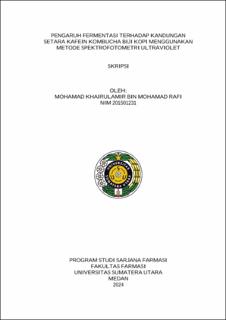| dc.description.abstract | Background: Kombucha is a fermented beverage known for its health benefits, including antioxidant and antibacterial properties. The starter culture used for kombucha fermentation is called SCOBY. Robusta coffee (Coffea canephora) contains valuable phytochemicals such as caffeine, which provides health benefits but may cause side effects if consumed in excess.
Objective: This study aims to measure the effect of fermentation time on the caffeine content in robusta coffee bean kombucha and assess its compliance with the SNI 01-7152-2006 standard.
Method: Caffeine content was analyzed using UV spectrophotometry, calculated using a regression equation, and further measured in each variation of coffee bean kombucha. Data analysis was performed using one-way ANOVA, followed by Tukey HSD and Duncan tests using SPSS 22. Validation included accuracy, precision, detection limit (LOD), and quantitation limit (LOQ).
Results: Caffeine identification in kombucha using UV spectrophotometry and phytochemical screening showed positive results. The analysis of caffeine levels in each 200 mL serving with fermentation time variations of 0, 3, 7, 14, and 21 days were 41,855 ± 0,00 mg; 29,8864 ± 0,00 mg; 24,1606 ± 0,01 mg; 22,6308 ± 0,02 mg; and 21,4106 ± 0,00 mg, respectively, with a P-value < 0.05. The lowest caffeine content was found after 21 days of fermentation. Validation showed precision (RSD = 1.314%), accuracy (% recovery = 96.20%), LOD = 3,1164 µg/mL, and LOQ = 10,3883 µg/mL.
Conclusion: Fermentation time affects the caffeine content in robusta coffee bean kombucha. The caffeine content decreases as the fermentation time increases, with the lowest caffeine content found in kombucha fermented for 21 days. | en_US |


